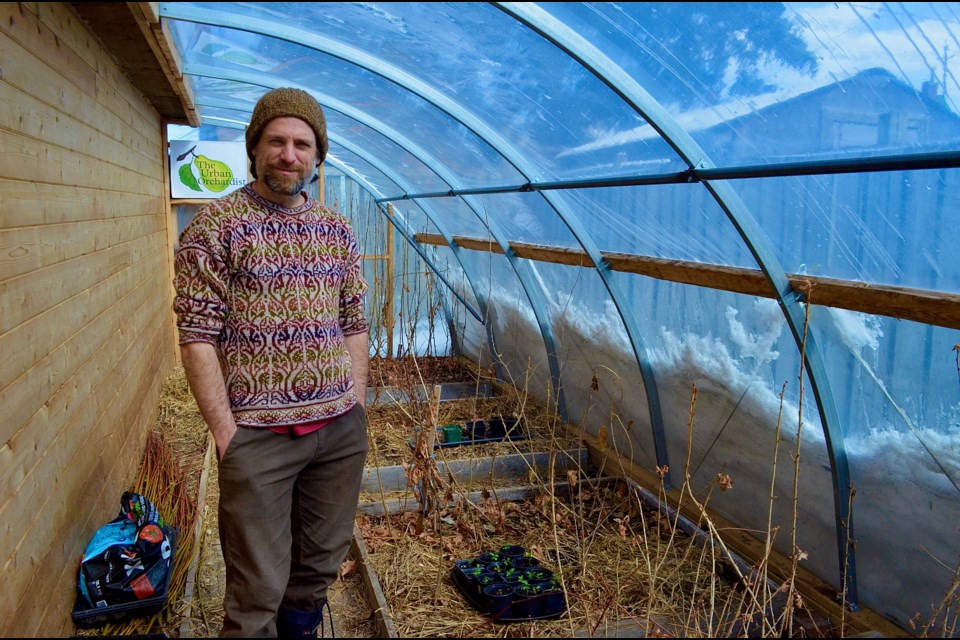In 1937, United States president Franklin D. Roosevelt said, “Forests are the lungs of our land, purifying the air and giving fresh strength to our people.”
Those timeless and prophetic words were spoken decades before scientists began promoting reforestation as a natural way to reduce the impact of climate change, and many thousands of years after our relationship to forests and trees became essential to our survival as a species.
“There is a lot of focus on reforestation as climate change mitigation and helping the urban environment, but also there is the food security angle,” said urban ochardist Matt Soltys. “So, as we reforest the city, I hope to help turn Guelph more edible, basically.”
Soltys has demonstrated from his Lawrence Avenue home and through his work as the Urban Orchardist – www.theurbanorchardist.com – how easily it can be done.
“Here is, basically, my home-base, urban propagation centre and I am also renting an acre at Ignatius,” he said. “I have all kinds of berry bushes I have propagated through cuttings. I have other fruit trees I have been growing out from seed, including apples and quince and pawpaw, which is a unique native fruit tree.”
He considers growing fruit trees much simpler than growing a vegetable garden every year.
“The work is really limited to just the annual application of compost and woodchip mulch for weed suppression and a bit of pruning,” he said. “Otherwise, the workload is way less than growing vegetables and they get bigger and more abundant each year.”
Over the past 12 years, Soltys has transformed the yard around his home into an urban orchard.
“This was all grass when I bought it in 2010 and now it is really what I would call a food forest,” he said. “I have 25 different species of fruit and nut trees. Hearty pecans and hazelnuts, pears, peach and plums, cherries, and all kinds of other things.”
Even his front hedge is edible.
“Last year I dug up half of this hedge and replaced it with black currant and raspberries,” he said. “It is partly to showcase how you can have a hedge that is edible and partly to share with anyone when the berries are ripe. They can nibble away as they walk by.”
His food forest yields far more than he needs to feed his family and sharing the bounty is a big part of the reward.
“When I am harvesting and the kids in the neighbourhood come to forage around, they love it and I think, what if everyone on our street had just one fruit tree,” he said. “Imagine how much more food could be grown in any single neighbourhood.”
Soltys has been closely monitoring the growth of a small patch of seedings in his greenhouse.
“These are from seeds I grew from a really special apple tree on Neeve Street,” he said. “It grows over the sidewalk and many neighbours like to harvest from it. It’s kind of a staple of the neighbourhood.”
The tree grows outside the home of Christelle Martin at the corner of Neeve and Toronto streets in The Ward. She invited Soltys to prune it and teach her how to care for it.
“I am just a renter, but it is important to me that this tree is well taken care of, and he is doing a great job with that,” said Martin. “It bears a lot of fruit and sometimes people stop and grab a couple apples. So, it is pretty cool. I moved from France, and we have a lot of peach and apricot trees over there, but I have never owned fruit trees on my property. So, I am interested but also, I needed guidance.”
Soltys believes simply teaching people to care for fruit trees that already exist in the city could have a substantial impact on the community’s food security.
“There are lots of fruit trees in the city that are underutilized,” he said. “Sometimes even one or two trees are too much for one family. So, that’s the thing. Growing a couple fruit trees builds an abundance that you can then share easily with people around you.”
Having an abundant and reliable local food source can make it easier to respond to rising prices, shortages, and interruptions in the national and global food markets such as those we’re experiencing now because of the COVID pandemic and the war in Ukraine.
“I am exploring the local fruit tree genetics to see how I can improve upon the local genetics, not just with taste, but especially with climate change adaptation as weather gets more unstable,” said Soltys. “Trees that are thriving here in the city are the ones that will offer the best chance for new genetic adaptability to a changing environment.”
It has been said that the best time to plant a tree is 20 years ago and the next best time is now. Whether you are doing it to help combat climate change, feed the community or both it’s a gift that keeps on giving.
“So, that is my angle,” said Soltys. “Fruit trees can live for many decades, and they can play an important role in food security, especially as food is getting more expensive. If you’re going to plant a tree, why not a fruit tree?”



